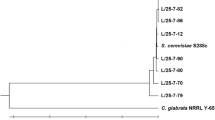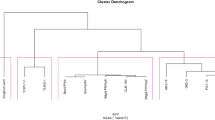Summary
The use of microorganisms in biotechnology is an important economic area of interest in Brazil, especially the use of Saccharomyces cerevisiae in the baking and alcohol fermentation industries. Dimorphism in S. cerevisiae (cell morphology alterations from budding cells to filamentous structures) has been observed in conditions of nitrogen and carbon deprivation and in the presence of fusel alcohols. This can be described as a defense mechanism that allows the yeast to forage for nutrients through cell elongation, hyphal formation and invasive growth. In this work fifteen industrial strains of S. cerevisiae (including haploid and diploid strains) isolated from the fermentative process for alcohol production were characterized for filamentation on solid culture media under growth conditions of carbon- and nitrogen-deprivation and in the presence of fusel alcohols. The majority of strains showed filamentation induced by isoamyl alcohol, butanol, isopropanol and isobutanol, but not by methanol. In rich medium (YEPD), both haploid and diploid strains showed invasive growth, although this kind of filamentous growth was more common in haploid strains. Similar results were observed when fructose or mannose was used as the sole carbon source. In nitrogen-deficient medium (SLAD) the strains did not filament. The results obtained indicate that the filamentation induced by higher alcohols and carbon deprivation (specially carbon) is a common process in industrial strains of S. cerevisiae contributing towards their maintenance/survival in adverse conditions.













Similar content being viewed by others
References
Banuett F (1998) Signalling in the yeasts: an informational cascade with links to the filamentous fungi. Microbiol Mol Biol Rev 62:249–274
Bony M, Barre P, Blondin B (1998) Distribution of the flocculation protein, Flop, at the cell surface during yeast growth: the availability of Flop determines the flocculation level. Yeast 14:25–35
Carlson M (1999) Glucose repression in yeast. Curr Opin Microbiol 2:202–207
Casalone E, Barberio C, Cappellini L, Polsinelli M (2005) Characterization of Saccharomyces cerevisiae natural populations for pseudohyphal growth and colony morphology. Res Microbiol 156:191–200
Ceccato-Antonini SR, Sudbery PE (2004) Filamentous growth in Saccharomyces cerevisiae. Braz J Microbiol 35:173–181
Ceccato-Antonini SR, Sudbery PE, Wightman R (2005) Molecular characterization of three haploid industrial strains of Saccharomyces cerevisiae and their responses to medium stress. In: Proceedings of the “XV Simpósio Nacional de Bioprocessos”, 2–5 August. Recife, Pernambuco, Brasil
Cullen PJ, Sprague Jr GF (2000) Glucose depletion causes haploid invasive growth in yeast. Proc Natl Acad Sci USA 97:13619–13624
Dickinson JR (1994) Irreversible formation of pseudohyphae by haploid Saccharomyces cerevisiae. FEMS Microbiol Lett 119:99–104
Dickinson JR (1996) ´Fusel´ alcohols induce hyphal-like extensions and pseudohyphal formation in yeasts. Microbiology 142:1391–1397
Gancedo JM (1998) Yeast carbon metabolite repression. Microbiol Mol Biol Rev 62:334–361
Gancedo JM (2001) Control of pseudohyphae formation in Saccharomyces cerevisiae. FEMS Microbiol Rev 25:107–123
Gibbs PA, Seviour RJ, Schmid F (2000) Growth of filamentous fungi in submerged culture: problems and possible solutions. Crit Rev Biotechnol 20:17–48
Gimeno CJ, Ljungdahl PO, Styles CA, Fink GR (1992) Unipolar cell divisions in the yeast Saccharomyces cerevisiae lead to filamentous growth: regulation by starvation and RAS. Cell 68:1077–1090
Lorenz MC, Cutler NS, Heitman J (2000) Characterization of alcohol-induced filamentous growth in Saccharomyces cerevisiae. Mol Biol Cell 11:183–199
Lorenz MC, Heitman J (1998) The MEP2 ammonium permease regulates pseudohyphal differentiation in Saccharomyces cerevisiae. EMBO J 17:1236–1247
Madhani HD, Fink GR (1998) The control of filamentous differentiation and virulence in fungi. Trends Cell Biol 8:348–353
Maneesri J, Azuma M, Torii S, Igarashi K, Ooshima H (2003) Characterization of a Saccharomyces cerevisiae with pseudohyphae and cloning of a gene complementing the mutation. Biosci Biotechnol Biochem 3:517–524
Palecek SP, Parih AS, Kron SJ (2002) Sensing, signalling and integrating physical processes during Saccharomyces cerevisiae invasive and filamentous growth. Microbiology 14:893–907
Roberts RT, Fink GR (1994) Elements of a single MAP kinase cascade in Saccharomyces cerevisiae mediate two developmental programs in the same cell type: mating and invasive growth. Genes Dev 8:2974–2985
Roberts CJ, Nelson B, Marton MJ, Stoughton R, Meyer MR, Bennett HA, He YD, Dai H, Walker WL, Hughes TR, Tyers M, Boone C, Friend SH (2000) Signaling and circuitry of multiple MAPK pathways revealed by a matrix of global gene expression profiles. Science 287:873–880
Acknowledgments
This work was financially supported by Fapesp (Fundação de Amparo à Pesquisa do Estado de São Paulo), under process n° 2004/06669–0. The authors wish to thank Dr Raymond Wightman for reviewing the manuscript.
Author information
Authors and Affiliations
Corresponding author
Rights and permissions
About this article
Cite this article
Silva, P.C.d., Horii, J., Miranda, V.S. et al. Characterization of industrial strains of Saccharomyces cerevisiae exhibiting filamentous growth induced by alcohols and nutrient deprivation . World J Microbiol Biotechnol 23, 697–704 (2007). https://doi.org/10.1007/s11274-006-9287-1
Received:
Accepted:
Published:
Issue Date:
DOI: https://doi.org/10.1007/s11274-006-9287-1




